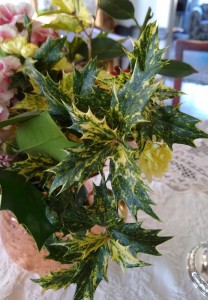 For years I have damned Osmanthus heterophyllus or false holly with faint praise–or no praise at all. Two of the prickly evergreen shrubs stand silently in front of the house, and for years I longed to remove them.
For years I have damned Osmanthus heterophyllus or false holly with faint praise–or no praise at all. Two of the prickly evergreen shrubs stand silently in front of the house, and for years I longed to remove them.
Why have I harbored such thoughts about a pair of innocent shrubs? For one thing, I didn’t choose them. They were already in place when I moved in, along with several shaggy yews and a collection of roses of Sharon that did nothing but self-seed. The yews are long gone and the roses of Sharon have been moved, standardized and fussed with for so long that I have developed a grudging respect for them. The osmanthus, on the other hand, languished in limbo for the longest time—not quite annoying enough to remove, but not loveable enough to play up.
A few years ago my relationship with my osmanthus duo shifted. I began to see the beauty in their variegated, holly-like leaves, which have proved useful in holiday decorating. I standardized their lumpy silhouettes into well-defined tree shapes, a move that also allowed me to plant smaller species at their feet. As the growing seasons passed, I grew more and more impressed by my osmanthus’ tenacity in the face of ambivalence.
Osmanthus are sometimes known as false holly or tea olive. Both names say something significant about the plants. Like holly, the shrubs and small trees in the osmanthus family are evergreen, often with glossy green leaves. Some species, including mine, sport sharp, holly-like spines on those leaves. That spiny foliage is very efficient at disguising the species’ membership in the olive family—also home to lilac and privet.
My osmanthus rarely flowers and has never produced fruit, but if it were to do so, the fruits would resemble small olives. The familial ties to beautiful, spring-flowering lilac seem improbable until you catch a whiff of the intensely fragrant flowers. Privet, when left unpruned, will also adorn itself with the same intoxicatingly-scented blooms. In the case of false holly, the Latin genus name is a great descriptor, deriving from the word “osme,” meaning “fragrant,” and “anthos,” meaning “flower.”
I used to tell people that it is hard to love a plant that begs to be pruned, then turns around and rewards your labors by shredding garden gloves and scratching skin. Over the years of living with my osmanthus, I came to realize my own horticultural hypocrisy. After all, I adore roses, which arm themselves with enough prickles to shame a porcupine and require much more frequent pruning.
My variegated Osmanthus heterophyllus are descended from plants that originated in Japan and Taiwan. Each prickly leaf is several inches long, with cream splashes on a background of dark, glossy green. Left to their own devices, the twin shrubs might grow as tall as 10 feet, but I keep them pruned to about 6 feet tall. Configured in standard or tree-form, the bottom two thirds of the trunks are left exposed. This barbering makes the plants more graceful in my medium-size suburban garden.
At one time I thought of digging up the two osmanthus and transplanting them into box-shaped planters. Standardized and boxed they might have marked the base of my front walk or possibly flanked the front steps, adding a nice formal touch. Because I am a lazy gardener, the boxing has never happened. It is probably a good thing, as that kind of radical upheaval would probably have resulted in damage to both the osmanthus and my back muscles.
Despite my rocky relationship with two osmanthus, I have come to respect them. Like all broadleaf evergreens, they add structure and color to the garden, especially in deepest, darkest winter when not even the hellebores dare to put out flowers. Osmanthus thrive in sun to partial shade and are absolutely undemanding. The spiny sprigs are perfect partners for true holly in winter decorations and arrangements.
Osmanthus heterophyllus is hardy to USDA Zone 7, which means the shrubs can withstand annual extreme minimum temperatures down to 0 degrees Fahrenheit. Other osmanthus species are more tender, including the intensely fragrant Osmanthus delavayi and Osmanthus fragrans, which I grow in a container indoors. Both bloom in spring and the scent of the former won the praise of garden writer Vita Sackville-West, who installed it in her celebrated garden at Sissinghurst.
Online and catalog vendors sell a number of false holly varieties. Mine is most likely ‘Variegatus.’ Lovers of colorful foliage might also try ‘Goshiki,’ with spiny leaves splashed and flecked with green, gold and cream, along with pink early in the season. ‘Purpureus’ features purple-tinged new growth that matures to green. In the spring, the better garden centers may offer one or more Osmanthus heterophyllus varieties. If you want to work ahead and order online, try ForestFarm, 14643 Watergap Rd, Williams, OR 97544; (541) 846-7269; www.forestfarm.com. Print catalog available.
True evergreen lovers will probably take to osmanthus quicker than I did. For everyone else, I recommend giving the shrub a chance. It may stick you with prickles when you prune, but it is also likely to grow on you.
